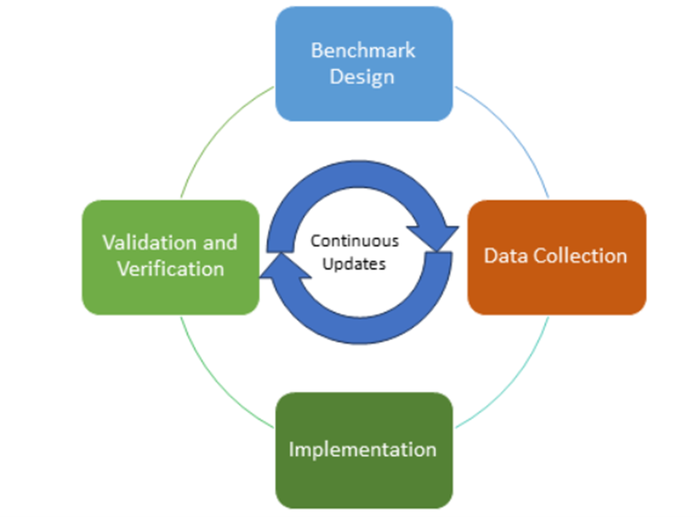
Insight and analysis on the data center space from industry thought leaders.
Benchmark to Breakthrough: How Standardized Testing Propels AI Innovation
Standardized benchmarks are critical to evaluating the performance of AI models and workloads in the data center, writes Amit Sanyal.
October 9, 2024

Artificial Intelligence (AI) is transforming industries on a global scale by performing complex tasks that were once considered the preserve of human intelligence. From acing the SAT to diagnosing medical images accurately, AI models have emulated, even surpassed, human performance on various benchmarks.
Benchmarks are essentially standardized tests that measure the performance of AI systems on specific tasks and goals, helping identify relevant and reliable data points for ongoing AI developments. These benchmarks offer researchers and developers invaluable insights by quantifying the efficiency, speed and accuracy of AI models, thus allowing them to optimize models and algorithms. As organizations harness the power of AI, these benchmarks become paramount to evaluating the performance of AI models and workloads across hardware and software platforms.
The Rise of AI Benchmarking Initiatives: A Paradigm Shift
AI models are complex systems requiring extensive development, testing, and deployment resources. Standardized benchmarks are essential to this process, offering a unified framework for evaluation.

In recent years, a few privileged companies have thrived on AI implementations, while numerous others are still discovering, exploring or navigating the path to effective operationalization. Companies harnessing AI have used proprietary tests to market their products and services as the best in the business, claiming to have outpaced competitors. This fragmented approach results in inconsistencies and limited knowledge transfer across industries.
Why have standardized benchmarking? Though some argue that benchmarks often fail to capture the real capabilities and limitations of AI systems, standardized benchmarking is crucial. By establishing a common ground for assessing AI models, benchmarks allow for a fair assessment of system performance, across departments, and guarantee that comparisons across platforms and models not only carry meaning but also accurately reflect performance capabilities, empowering decision-makers to drive innovation with confidence.
Methodologies Behind Establishing Standardized Benchmarks
To keep up with the latest advancements and capabilities in AI, benchmarks need to be continuously assessed, developed and adapted to prevent them from becoming outdated and liable to inconsistent evaluations.
Designing and implementing benchmarks for AI systems is a comprehensive process that involves several critical phases. The first step is benchmark design, where organizations determine the specific AI model, its datasets and key performance indicators (KPIs) that align with its goals and functionalities. By establishing concrete metrics, organizations can quantitatively and consistently assess AI performance. This is followed by data collection, in which high-quality, representative datasets must be curated to cover a variety of scenarios and use cases to eliminate bias and reflect real-world challenges.
Next, the implementation phase involves the strategic configuration of AI models within a standardized testing environment, to establish a baseline for performance evaluation and benchmarking. Validation and verification come next, where the performance of AI models is measured against predefined metrics to ensure the accuracy and reliability of outcomes.
Finally, to keep up with evolving technologies, benchmarks require regular iterations to integrate the latest advancements and maintain relevance.
Unveiling the Implications of AI Evolution for Benchmarking Standards
IT industry consortia have long utilized benchmarking to drive innovation. Notably, the standards from the Standard Performance Evaluation Corporation (SPEC) and Transaction Processing Performance Council (TPC) standards have set computer and database performance benchmarks, guiding tech solutions' development and scalability.
A good example of this is MLCommons, which aims to enhance AI model performance by developing industry-standard benchmarks that transcend traditional limitations. This endeavor is powered by a broad industry consortium, including leading companies, startups, academics and non-profit organizations, shaping the future of AI innovation.
Through MLCommons, today's tech-savvy strategists and decision-makers have many benchmarks available, with each serving a unique purpose and offering critical insights into the performance, scalability and safety of AI technologies.
Paving the Way for a Collaborative Benchmarking Ecosystem
Collaboration is a lynchpin for success in the dynamic realm of AI. As organizations embrace AI's transformative power, the collaborative benchmarking ecosystem underscores a paradigm shift in how AI performance is measured and optimized. By pooling resources, expertise, and perspectives, industry leaders fuel innovation and shape a future where AI sets new standards of excellence and ingenuity.
By fostering a collaborative ecosystem, industry initiatives pave the way for shared knowledge, insights and best practices. This exchange of information serves as the catalyst for advancement of AI technologies and helps identify new areas for improvement. It also ensures that industry stakeholders collectively contribute toward setting new benchmarks and raising the bar for AI performance evaluation.
Furthermore, these standardized benchmarks and collaborative ethos help end users accelerate the pace of innovation, resource optimization, consistency and reliability of AI systems. As AI continues to evolve, standardized benchmarks and collaborative benchmarking ecosystems will only become increasingly important, reshaping industries and redefining possibilities for the future.
Amit Sanyal is Senior Director of Data Center Product Marketing at Juniper Networks.
About the Author
You May Also Like









